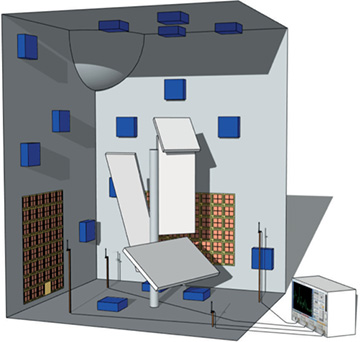
Researchers in France demonstrated the possibility of wave-based analog computing using wavefront shaping of Wi-Fi in a home or office building. To do the demo, the team constructed a small model “room” a cubic meter in size. The orange patches are metasurface arrays, which shape the Wi-Fi waves; the blue patches are absorbers used to tune the cavity’s quality factor. Four Wi-Fi antennas both generate and receive the signal. [Image: P. del Hougne and G. Lerosey, “Generating chaos for wave-based analog computation: Demonstration with indoor wireless communication signals,” Phys. Rev. X, doi: 10.1103/PhysRevX.8.041037]
In an intriguing demonstration, a pair of French researchers have shown how an ordinary room or office with a Wi-Fi signal might be used as a cavity to perform analog, wave-based computation—including the kind of computationally intensive operations that underlie emerging “artificial neural net” (ANN) computer architectures (Phys. Rev. X, doi: 10.1103/PhysRevX.8.041037).
The team’s technique rests on using wavefront shaping at the front end as alternative to the intricate, difficult-to-fabricate metamaterial and circuit designs that underlie recent many demos of analog computing. The researchers believe that it offers a potentially intriguing alternative route toward low-cost, energy-efficient computation in an increasingly processing-intensive era of ANN computation and big data.
Analog computing’s resurgence
We’re all familiar with the digital computers that reside on our desks, in our laps or in our pockets. Yet some of the earliest computers were analog devices that performed computational tasks on wave parameters, such as a light wave’s amplitude, rather than on digital bits. Analog approaches ultimately lost out to electronics, as the benefits of silicon lithography and Moore’s law brought about the massive integration and scaling that have fostered today’s digital age.
In recent years, however, as Moore’s law has seemed to run up against its physical and thermal limits, many researchers have taken another look at special-purpose analog optical computing to approach certain kinds of energy- and processing-intensive problems. Light-based analog computing, thought to be inherently energy efficient, could have a particularly interesting role in the ANN architectures that underlie machine-learning systems. That’s because those architectures center around power-hungry, iterative matrix multiplications that can quickly sap a digital computer’s energy budget (see “Neuromorphic photonics,” OPN, January 2018).
The new relevance of analog computing has led to some impressive recent demonstrations of reconfigurable, analog silicon-photonic ANN circuits featuring interconnected Mach-Zehnder interferometers, among other configurations. The problem with these approaches—according to the Paris-based coauthors of the new PRL study, Phillip del Hougne of the Institut Langevin and Geoffroy Lerosey of the firm Greenerwave—is that they involve “intricate material designs that are difficult (if not impossible, to date) to fabricate.”
Computing in a low-Q cavity
Del Hougne and Lerosey suggested that the same sort of reprogrammable analog computation might be done in a radically different way—by custom-shaping the input wavefront itself to perform specific computations. In principle, they suggest, using such wavefront shaping as the adjustable parameter allows the bulk optics or intricate engineered materials commonly used in analog computing demonstrations to be replaced by any random medium—even by the bouncing of an ordinary Wi-Fi signal in a typical room or office.
To test the concept’s feasibility, del Hougne and Lerosey set up tiny “room” consisting of a metal cavity approximately 1 m3 in size, filled with irregular “furniture” (see image above). They dotted the room with electromagnetic absorbers to reduce the cavity’s quality factor to a level “comparable to the one we measure in an office room.” Two of the cavity walls include 88-pixel reflective-array metasurfaces that can be tuned to shape Wi-Fi waves; those waves are provided by four monopole antennas, which also serve as receivers.
The process of turning this model room into a computer begins by tweaking each pixel of the wavefront-shaping metamaterial, and measuring its impact on the complex Wi-Fi field. These measurements are rolled up into an “impact matrix” that characterizes the room. Once that one-off step is done, the impact matrix can be used as a guide for adjusting the metamaterial and shaping the wavefront to “program” the room to perform specific matrix operations.
Toward a “complete hardware architecture”
Using the setup, del Hougne and Lerosey found that they could execute, as a proof of concept, a discrete Fourier transform operation on four different input vectors. The model room’s computational results met theoretical expectations, with an average error rate of only 3.8 percent.
While the proof of concept presented by the researchers envisions a low-Q, room-scale computer, del Hougne and Lerosey note that for a more practical implementation, the idea can be scaled down orders of magnitude, to rack-scale cavities operating at substantially higher frequencies than the Wi-Fi band. Further, they acknowledge that their demo setup, with only four input Wi-Fi signals, can’t keep up in speed with today’s digital computers—but they calculate that, given around 30 inputs, it could match the speed of GHz-scale machines. And they find a distinct potential advantage in energy efficiency, with energy consumption of an optimized system estimated at 1 pJ per operation. That’s two orders of magnitude less than the consumption for traditional computers.
Del Hougne and Lerosey stress the “practicality and reconfigurability” of their scheme, which rests on the well-trodden ground of optical wavefront shaping in random media, rather than exotic, difficult-to-manufacture metamaterial designs. Those characteristics, they believe, could give the approach an important role in “the renaissance of specific-purpose computing” being driven by the advance of ANNs and machine learning, which put a premium on high-speed, low-power processing of large volumes of data.
The researchers even envision the use of multiple cascading cavities, strung together with nonlinear elements, to create a “complete, tailored hardware architecture” for ANN implementations. Think about that next time you sign into your Wi-Fi at work.
